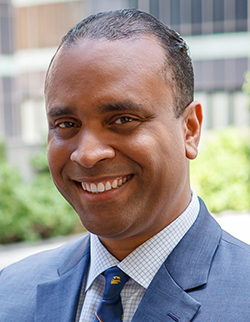Dealing with Lower Back Pain? It Might Be Your Hip
Advice to improve your movement, fitness, and overall health from the world's #1 in orthopedics.
Lower back pain can have many culprits—a pulled muscle, an overuse injury, a herniated disc. In other cases, the source of the issue isn’t even the back itself. Sometimes, it’s a problem with the hip, says George Cyril, MD, FAAPMR, an assistant attending physiatrist at HSS.

“Especially in younger people experiencing back pain, up to 90% of those I see in my practice actually have a hip issue, such as hip impingement,” he adds. “A lot of times, we end up treating the hip instead of the spine, and the pain goes away. It’s actually very common.”
The structures of the lower body are intricately interconnected, particularly the hips and spine, so pain can appear in unexpected places depending on how a person moves, their general activity level and how they’re compensating for the original issue.
“It can sometimes be difficult to determine the source of pain,” says Jessica Hettler PT, DPT, MHA, ATC, SCS, OCS, Cert MDT, a physical therapist at HSS. “Whether the pain is from the hip or the spine can be tricky to determine, since symptoms can be similar. It really requires getting a clear history from the patient, asking open-ended questions and combining that with our physical examination.”
Treatments for Hip Pain
Hip impingement is common among many active patients who are experiencing back pain. In this condition, there is abnormal alignment between the bones of the ball and socket in the hip joint. “We think it’s an anatomical defect, which means that someone is born with it or has a genetic predisposition to it,” says Dr. Cyril. “In some people, it gets worse or more developed over time, which leads to pain.”
The first form of treatment is nonsurgical—usually physical therapy. The goal is to help people adapt to the issue rather than fixing it by changing the way they move, as well as by improving range of motion and strengthening the muscles that support the hip joint. “From there, a patient could possibly transition to a skilled exercise physiologist to help them build a safe workout program for the sports they like to participate in,” says Hettler.
Another potential hip-related cause of back pain is hip-spine syndrome, in which people experience both hip pain and back pain at the same time, and the source isn’t always clear. It generally occurs in younger adults who’ve been experiencing back pain that won’t let up.
“This is actually very common, as people tend to wait on symptoms thinking it will go away and symptoms may change,” says Hettler. Physical therapy is also the place to address this, she adds.
Surgery for Hip Issues
Some people with hip impingement may benefit from a procedure called a hip arthroscopy. This is a minimally invasive technique, which means it doesn’t require a large cut in the skin or long recovery time in the hospital. (Patients often go home the same day.) If you have the procedure, you’ll use crutches for about one to two weeks after surgery and do six weeks of physical therapy.
If those options don’t solve the issue, the next step might be surgery. Up to 30% of people with hip impingement eventually go on to have surgery, Dr. Cyril says. More on surgery for hip impingement.
Studying the Total Picture
As a general rule, if you’ve been having back pain for a while—months or years—it’s time to see a doctor. Similarly, if you’ve been having nonsurgical treatments like injections or physical therapy for your back pain for a long time and it isn’t improving, that’s also a reason to see a specialist like a physiatrist.
Whatever the cause of your pain, whether it’s in the back, hip, knee or elsewhere, it’s important to get a thorough assessment of your entire body, Dr. Cyril says. “Your physician should be looking at the total picture,” he adds. “The same goes for any area you’re experiencing pain. If you have shoulder pain, the cause could be in your neck, for example.”
Once you receive a recommendation for treatment—physical therapy, say—give it a little time to work before moving on to different options. It’s also important that your PT closely monitors your progress to see what’s working and what’s not, says Hettler. “PTs need to monitor symptoms between sessions and change their movement strategies to properly help resolve these issues.” If you’re still feeling pain after that point, it’s reasonable to try a different route.
Published 4/22/2024





